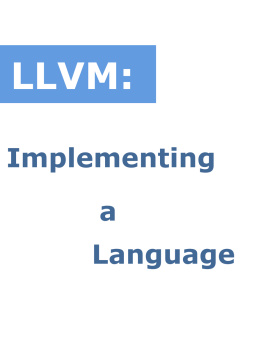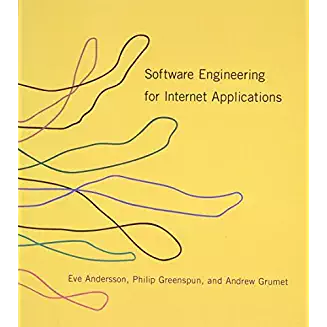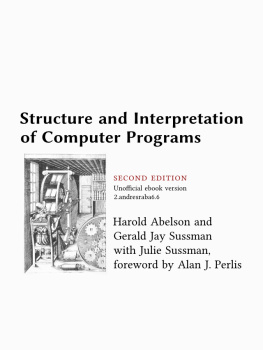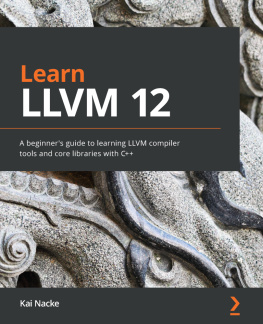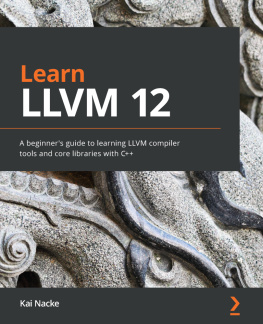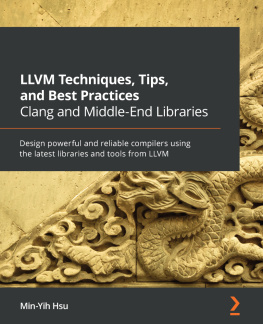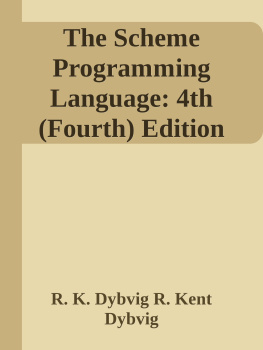it-ebooks - Implementing a language with LLVM
Here you can read online it-ebooks - Implementing a language with LLVM full text of the book (entire story) in english for free. Download pdf and epub, get meaning, cover and reviews about this ebook. year: 2017, publisher: iBooker it-ebooks, genre: Home and family. Description of the work, (preface) as well as reviews are available. Best literature library LitArk.com created for fans of good reading and offers a wide selection of genres:
Romance novel
Science fiction
Adventure
Detective
Science
History
Home and family
Prose
Art
Politics
Computer
Non-fiction
Religion
Business
Children
Humor
Choose a favorite category and find really read worthwhile books. Enjoy immersion in the world of imagination, feel the emotions of the characters or learn something new for yourself, make an fascinating discovery.
- Book:Implementing a language with LLVM
- Author:
- Publisher:iBooker it-ebooks
- Genre:
- Year:2017
- Rating:4 / 5
- Favourites:Add to favourites
- Your mark:
- 80
- 1
- 2
- 3
- 4
- 5
Implementing a language with LLVM: summary, description and annotation
We offer to read an annotation, description, summary or preface (depends on what the author of the book "Implementing a language with LLVM" wrote himself). If you haven't found the necessary information about the book — write in the comments, we will try to find it.
Implementing a language with LLVM — read online for free the complete book (whole text) full work
Below is the text of the book, divided by pages. System saving the place of the last page read, allows you to conveniently read the book "Implementing a language with LLVM" online for free, without having to search again every time where you left off. Put a bookmark, and you can go to the page where you finished reading at any time.
Font size:
Interval:
Bookmark:
Welcome to Chapter 3 of the "Implementing a language with LLVM" tutorial. This chapter shows you how to transform the Abstract Syntax Tree, built in Chapter 2, into LLVM IR. This will teach you a little bit about how LLVM does things, as well as demonstrate how easy it is to use. It's much more work to build a lexer and parser than it is to generate LLVM IR code. :)
Please note: the code in this chapter and later require LLVM 2.2 or later. LLVM 2.1 and before will not work with it. Also note that you need to use a version of this tutorial that matches your LLVM release: If you are using an official LLVM release, use the version of the documentation included with your release or on the llvm.org releases page.
In order to generate LLVM IR, we want some simple setup to get started. First we define virtual code generation (codegen) methods in each AST class:
/// ExprAST - Base class for all expression nodes.class ExprAST {public: virtual ~ExprAST() {} virtual Value *Codegen() = 0;};/// NumberExprAST - Expression class for numeric literals like "1.0".class NumberExprAST : public ExprAST { double Val;public: NumberExprAST(double val) : Val(val) {} virtual Value *Codegen();};...The Codegen() method says to emit IR for that AST node along with all the things it depends on, and they all return an LLVM Value object. "Value" is the class used to represent a "Static Single Assignment (SSA) register" or "SSA value" in LLVM. The most distinct aspect of SSA values is that their value is computed as the related instruction executes, and it does not get a new value until (and if) the instruction re-executes. In other words, there is no way to "change" an SSA value. For more information, please read up on Static Single Assignment - the concepts are really quite natural once you grok them.
Note that instead of adding virtual methods to the ExprAST class hierarchy, it could also make sense to use a visitor pattern or some other way to model this. Again, this tutorial won't dwell on good software engineering practices: for our purposes, adding a virtual method is simplest.
The second thing we want is an Error method like we used for the parser, which will be used to report errors found during code generation (for example, use of an undeclared parameter):
Value *ErrorV(const char *Str) { Error(Str); return 0; }static Module *TheModule;static IRBuilder<> Builder(getGlobalContext());static std::map NamedValues;The static variables will be used during code generation. TheModule is the LLVM construct that contains all of the functions and global variables in a chunk of code. In many ways, it is the top-level structure that the LLVM IR uses to contain code.
The Builder object is a helper object that makes it easy to generate LLVM instructions. Instances of the IRBuilder class template keep track of the current place to insert instructions and has methods to create new instructions.
The NamedValues map keeps track of which values are defined in the current scope and what their LLVM representation is. (In other words, it is a symbol table for the code). In this form of Kaleidoscope, the only things that can be referenced are function parameters. As such, function parameters will be in this map when generating code for their function body.
With these basics in place, we can start talking about how to generate code for each expression. Note that this assumes that the Builder has been set up to generate code into something. For now, we'll assume that this has already been done, and we'll just use it to emit code.
Generating LLVM code for expression nodes is very straightforward: less than 45 lines of commented code for all four of our expression nodes. First we'll do numeric literals:
Value *NumberExprAST::Codegen() { return ConstantFP::get(getGlobalContext(), APFloat(Val));}In the LLVM IR, numeric constants are represented with the ConstantFP class, which holds the numeric value in an APFloat internally (APFloat has the capability of holding floating point constants of Arbitrary Precision). This code basically just creates and returns a ConstantFP. Note that in the LLVM IR that constants are all uniqued together and shared. For this reason, the API uses the foo::get(...) idiom instead of new foo(..) or foo::Create(..).
Value *VariableExprAST::Codegen() { // Look this variable up in the function. Value *V = NamedValues[Name]; return V ? V : ErrorV("Unknown variable name");}References to variables are also quite simple using LLVM. In the simple version of Kaleidoscope, we assume that the variable has already been emitted somewhere and its value is available. In practice, the only values that can be in the NamedValues map are function arguments. This code simply checks to see that the specified name is in the map (if not, an unknown variable is being referenced) and returns the value for it. In future chapters, we'll add support for loop induction variables in the symbol table, and for local variables.
Value *BinaryExprAST::Codegen() { Value *L = LHS->Codegen(); Value *R = RHS->Codegen(); if (L == 0 || R == 0) return 0; switch (Op) { case '+': return Builder.CreateFAdd(L, R, "addtmp"); case '-': return Builder.CreateFSub(L, R, "subtmp"); case '*': return Builder.CreateFMul(L, R, "multmp"); case '<': L = Builder.CreateFCmpULT(L, R, "cmptmp"); // Convert bool 0/1 to double 0.0 or 1.0 return Builder.CreateUIToFP(L, Type::getDoubleTy(getGlobalContext()), "booltmp"); default: return ErrorV("invalid binary operator"); }}Binary operators start to get more interesting. The basic idea here is that we recursively emit code for the left-hand side of the expression, then the right-hand side, then we compute the result of the binary expression. In this code, we do a simple switch on the opcode to create the right LLVM instruction.
In the example above, the LLVM builder class is starting to show its value. IRBuilder knows where to insert the newly created instruction, all you have to do is specify what instruction to create (e.g. with CreateFAdd), which operands to use (L and R here) and optionally provide a name for the generated instruction.
One nice thing about LLVM is that the name is just a hint. For instance, if the code above emits multiple addtmp variables, LLVM will automatically provide each one with an increasing, unique numeric suffix. Local value names for instructions are purely optional, but it makes it much easier to read the IR dumps.
LLVM instructions are constrained by strict rules: for example, the Left and Right operators of an add instruction must have the same type, and the result type of the add must match the operand types. Because all values in Kaleidoscope are doubles, this makes for very simple code for add, sub and mul.
On the other hand, LLVM specifies that the fcmp instruction always returns an i1' value (a one bit integer). The problem with this is that Kaleidoscope wants the value to be a 0.0 or 1.0 value. In order to get these semantics, we combine the fcmp instruction with a uitofp instruction. This instruction converts its input integer into a floating point value by treating the input as an unsigned value. In contrast, if we used the sitofp instruction, the Kaleidoscope <' operator would return 0.0 and -1.0, depending on the input value.
Value *CallExprAST::Codegen() { // Look up the name in the global module table. Function *CalleeF = TheModule->getFunction(Callee); if (CalleeF == 0) return ErrorV("Unknown function referenced"); // If argument mismatch error. if (CalleeF->arg_size() != Args.size()) return ErrorV("Incorrect # arguments passed"); std::vector ArgsV; for (unsigned i = 0, e = Args.size(); i != e; ++i) { ArgsV.push_back(Args[i]->Codegen()); if (ArgsV.back() == 0) return 0; } return Builder.CreateCall(CalleeF, ArgsV, "calltmp");}Font size:
Interval:
Bookmark:
Similar books «Implementing a language with LLVM»
Look at similar books to Implementing a language with LLVM. We have selected literature similar in name and meaning in the hope of providing readers with more options to find new, interesting, not yet read works.
Discussion, reviews of the book Implementing a language with LLVM and just readers' own opinions. Leave your comments, write what you think about the work, its meaning or the main characters. Specify what exactly you liked and what you didn't like, and why you think so.

